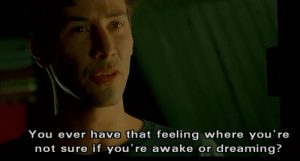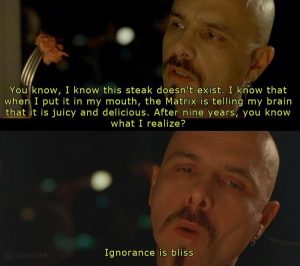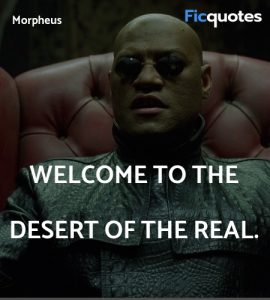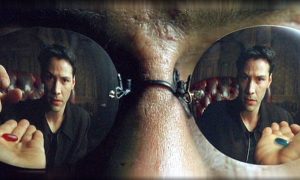
Augmented Realities and Perceptions in the Matrix trilogy
Augmented technologies create or extend realities. This is conducted by immersing the user in a digital environment having applications in different domains. It projects computer-generated augmentations on top of reality. This assists us in performing objectives and tasks with maximum efficiency. It is a methodology rendered to visualise real-world data and illuminate it by intuitionistic logic. Thus virtual elements resonate with the present reality to an extent for the user to be immersed in a digital world. Augmented reality has been in development for numerous decades. Ivan Sutherland in 1969 developed the first AR gadget called the ‘Sword of Damocles’ (Bridget Poetker, August 22, 2019). The system configures computer graphics to visualise to users simple wireframe drawings. As an enhancement to perceptual reality, it intertwines reality with virtual objects creating a romanticism or phantasm illuminative product. This archetypal notion of hyperreality is deconstructed in the 1999 series ‘The Matrix’.
The Philosophy of the Matrix
At the core of the matrix trilogy, lies the disturbing principality that the world is nothing but perceptions controlled by malevolent forces. Whilst the film coherently argues about nature, the truth of reality, and possibilities of choice and free will. The philosophy of the matrix trilogy demonstrates the core concepts of augmented realities. The potential of hyperreality in immersive technologies allows us to doubt the genuineness in reality. This is visible in the protagonist Neo who is subjected to the matrix system and its augmented perceptions and realities are fragmented.

Augmented realities can project a notion of delirium, which was utilised as a transition in the plot to demonstrate to audiences that pseudo forms of awakening convey unreliability in the senses. Just at the moment, it disappears from view, computing has acquired the capacity to frame human perception … The computer has now become an actor in the field of reality. In a single step, the capacity to affect us has become amplified beyond all expectations (Pesce, 2021). In which reality and the idea of genuineness is a core theme in the trilogy of the matrix.‘ Mark Pesce in his academic paper ‘The last days of reality constructs an argument of how programs can be indomitable and how transgressions of ‘machine learning’ have improved in achieving their goals. Programs with augmented reality have formed a simulation of each of its individual users through surveillance then use that simulation to filter away the content that disjoints users off their site.
‘Last year, it was still quite human-like when it played, but this year it became a God.’
(Ke Jie, May 2017) (THE LAST DAYS OF REALITY, MARK PESCE, Page 71)
This is demonstrated through the Matrix as Cypher who was red-pilled and assigned to the Zion hovercraft had a motif of ‘ignorance being bliss. Due to the harsh realities of the real world, Cypher wanted to return to the matrix system and be immersed in the world as an important person with wealth and credible status. This is aligned with contemporary technologies of augmented realities where the presence in a virtual world can be a flawless utopia. In conjunction with the films, the Matrix used a system to abolish humanity’s awareness of a fragmented and destroyed world.

To be is to be Perceived – Morpheus
George Berkeley’s work in immaterialism contemplates that there is no such thing as matter in this world. All that is projected is our ideas, sensory experiences in perceiving the mind. What we visualise according to Berkley is a collection of ideas, matter that you can see is a sensory experience as opposed to an objectively material object (A.C. Grayling). This is firmly woven into the story of the matrix, hence why your mind is able to make death or injury real. In alignment with this philosophy of augmentation of reality, this is demonstrated in the matrix as certain objects can be manipulated once realising it does not matter but our minds perceiving or having sensory experiences. Barkley would contentiously state that our consciousness and how we perceive the world gives rise to different ideas which then inform how the world was made or changed. This is exemplified in Mark Pesce’s ‘Augmented Reality as he notes ‘what we bring to our experience of place comes from both within and outside us. That ‘inertia’, its resistance to change, gives the world solidarity and validity that we rely on (Augmented Reality, Pesce, page 5)
Augmented realities have developed and transformed to a point that it is more sensual and progressively being more connected with our bodies. The Matrix’s ubiquity is weaving itself in the fabric of every fabricated object, transgressing past our mindsets of perception. These technologies of augmented realities possess the capabilities in providing hyperactive and sensory behaviors. Morpheus would coherently address that artificiality of the augmented life in the matrix is not what you visualise but what you believe. As Mark Pesce’s states ‘we have computers that can now play with our heads, but we have no rules to restrain their engagement’. The computer of augmented realities has the power and sovereignty to become an actor in the field of reality. It is beyond any framework or structural integration of design, ethics, and law where information and misinformation are consumed, occupying the internal hyperspace of human thought. This dystopian concept of augmented realities is conveyed in the Matrix as the machines went from consuming data, information, human ethos and pathos, to harvesting the energy of individuals to source a matrix system.
Don’t think you are, know you are – Morpheus
Neo was able to further bend and manipulate the malleability of his augmented reality. A simulation does not care about physiology, strength, or skill. As all of these are mutable or accessible in the matrix system. Morpheus demonstrates this in the first film in the introduction sequence with Neo, explaining that ‘it’s the mental projection of our digital self, what is real? How do you define real?’. Simulation in augmented realities is the imitation of the operation of a real-world process or system over time. Jean Baudrillard’s text of ‘Simulacra and Simulation’ is referenced in the Matrix as the existence and growth of simulacra would further drift us in this new reality and can take a life of its own. Whilst reality itself erodes to the point it becomes a desert, hence referencing Morpheus ‘welcome to the desert of the real’. The virtual initiatives projected by the matrix system and the machines are to create the augmented reality to be so minute in detail that individuals are not even aware they are immersed into it.

Initially, the matrix was designed for humans to heighten a sense of euphoria and live without suffering. However, the burden of freedom was too much for users in augmented reality, as we were fallible and untrustworthy creatures. Instead, we were to have authority and semblance of control in our actions, as there are a few members within the matrix that are determined to escape their augmented realities. The visualisation of the matrix further was unique in delineating and juxtaposing both worlds, by showing how everything in the matrix is decayed, monolithic, and grid-like in green. This design point would extend all the way to the cast, whereas in the real world, people were not as fine-tuned and people had more organic quality. The real world is industrially compacted and riddled with cables lying everywhere, reflecting that we are constantly maintaining and shifting our perceptions of reality. This is perpetuated to our current visualisation of augmented reality devices, the vibrancies of colours, animations, and digital enlightenment create a sense of enjoyment in escaping the dullness of the real world. You can see the juxtaposition of bureaucracy in the prophetic man in the matrix. The counselor reminds Neo and the audience of the significance and duality of augmented reality stating that ‘ I like to be reminded that this city survives because of these machines. It demonstrates the sentinel comfort and spirituality that machinery can provide through augmented reality technologies. As the matrix also establishes that the machines were endowed with the spirit of man in the beginning, yet corrupted due to the influx of accumulated data of humanity. Its possibilities are endless through augmented realities, in which users are constrained to their own civil enlightenment and liberties.

Yianni Laliotis
References
Hartanto, D., Kampmann, I. L., Morina, N., Emmelkamp, P. G. M., Neerincx, M. A. & Brinkman, W.-P. (2014). Controlling Social Stress in Virtual Reality Environments. PLOS One, 9 (3), e92804.
Slater, M. & Wilbur, S. (1997). A Framework for Immersive Virtual Environments (FIVE): Speculations on the Role of Presence in Virtual Environments. Presence: Teleoperators and Virtual Environments, 6 (6), 603-616.
Bridget Poetker, August 22, 2019
https://www.g2.com/articles/history-of-augmented-reality
Augmented reality : unboxing tech’s next big thing, Pesce, Mark, author, 2021
Berkeley’s Argument for Immaterialism
http://www.acgrayling.com/berkeleys-argument-for-immaterialism
The last days of reality, Pesce, Mark, 2017
https://sydney.alma.exlibrisgroup.com/leganto/public/61USYD_INST/citation/16155201940005106?auth=SAML
Welcome to the Matrix! Opportunities and Risks of the Virtual World, written by Sarah Mayr
https://www.in-mind.org/article/welcome-to-the-matrix-opportunities-and-risks-of-the-virtual-world